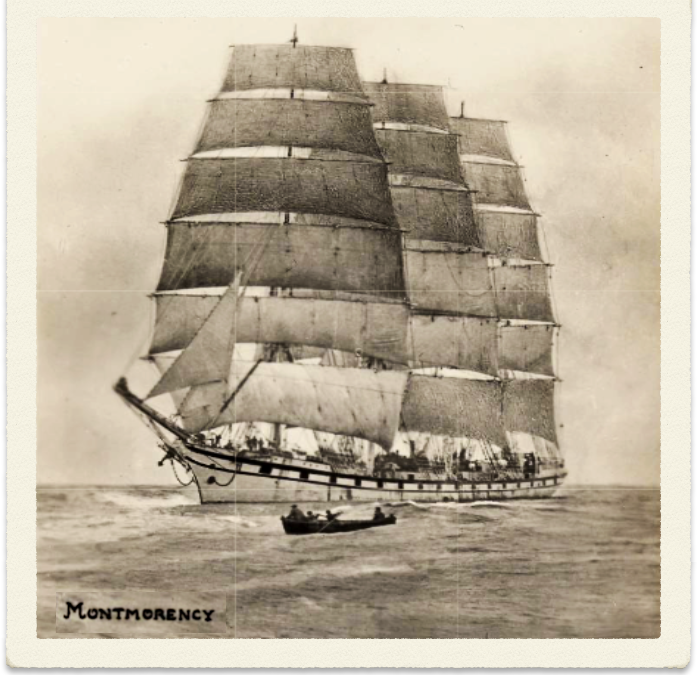
Rosewood History
James PONTING and Selina HILL
Name: James PONTING
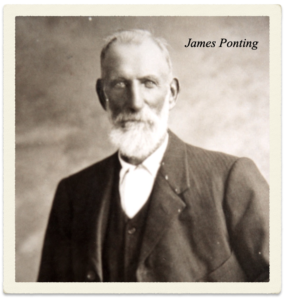 Occupation: Timbergetter; Farmer at Tallegalla; Proprietor of Commercial Hotel
Occupation: Timbergetter; Farmer at Tallegalla; Proprietor of Commercial Hotel
Birth: 1841 Calne, Wiltshire, England
[Registered at Calne, Wiltshire, England, Jul-Aug-Sep 1841, Volume 8 Page 266]
Baptised: 10th September 1841, Calne, Wiltshire, England
Resided: 1851, Coneygre Farm, Calne with his widowed mother.
Resided: 1861, The Quarry, Calne with his mother and her granddaughter Sarah J. E. Ponting.
Immigration: 7th April 1862, the Montmorency arrived Moreton Bay from London 1st January.
Land: 8th April 1872, 80 acres in parish of Walloon (Portion 520) See Land Purchase
Death: 10th May 1925, Tallegalla, Queensland aged 83 years
Burial: 11th May 1925, Tallegalla Pioneer Cemetery (Rev. J. Sterling, of the Methodist Church)
Father: James PONTING (1797-1842 Miller/Yoeman) See Probate
Mother: Mary Ann BUTLER (Farmer)
Marriage: 18th July 1863, at the residence of the bride’s parents, Brisbane, Queensland
Spouse: Selina HILL
Birth: 1847, Stinchcombe, Gloucestershire, England
Registered at Dursley, Gloucestershire, England Oct-Nov-Dec 1847, Volume 11 Page 292
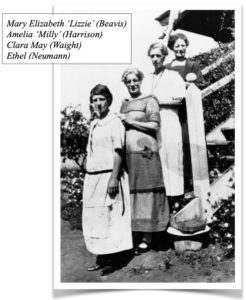 Baptised: 24th January 1847, Stinchcombe, Gloucestershire, England
Baptised: 24th January 1847, Stinchcombe, Gloucestershire, England
Immigration: 9th October 1857, the Blenheim arrived Moreton Bay from Plymouth 24th June.
Death: 21st August 1904, Tallegalla, Queensland aged 57 years
Cause: Pleurisy and Inflammation
Burial: 22nd August 1904, Tallegalla Pioneer Cemetery (Rev. Granger Smith, Methodist minister, of Lowood.)
Father: James HILL
Mother: Christiane MILLS
Children: 14
Rosina PONTING (1864-1909) = William BOUGHEN
Clara May PONTING (1865-1937) = John WAIGHT
Albert Edwin Hill PONTING (1867-1931) = 1. Mary LAING 2. Helga Emilie HENNINGSEN
Amelia PONTING (1870-1870)
Mary Elizabeth PONTING (1871-1937) = Walter BEAVIS
Amelia PONTING (1873-1927) = Arthur Edward Samuel HARRISON
George Aaron PONTING (Twin) (1876-1939) = Annie Sophia MILLER
James Moses PONTING (Twin) (1876-1944) = Mary Jane LANE
Clara May PONTING (1878-1937) = John WAIGHT
Henry PONTING (1880-1949) = Anastasia Ita KINGTON
Arthur William PONTING (1883-1917)
Ethel PONTING (1885-1947) = Wilhelm Emil NEUMANN
Charles PONTING (1888-1941) = Odo Wereburga KINGTON
John Thomas PONTING (1890-1967) = 1. Mary Elsie FREEMAN 2. Alice Naomi WASS
James Ponting was only 8 months old when his father died. His mother stayed on their 52 acre farm, Coneygre Farm in Calne, Wiltshire and ran it with he assistance of two men and one boy.
When James decided to leave England for Australia, it is more likely that he boarded the Montmorency at Plymouth rather than at the Downs in London. He was 21 years old and one of the 195 immigrants who made the 93 day voyage to Queensland. When the ship was a little north of the equator, they encountered a vessel from China, the Sea Snake. Because the vessel was boarded, it gave the Montmorency passengers an opportunity to write letters which could be taken by the Sea Snake back home to England.
James and the other immigrants were bought up to the wharf by the steamer Ipswich three days later. While at the immigration depot at North Brisbane, he would have received a copy of the Brisbane Courier’s monthly “Summary For Europe” which was published on Saturday 12th April and dispatched by the English mails. The newspaper gave a copy free of charge to all heads of families and adult males or female passengers on the Montmorency, so they could send it to their friends at home.
Jame Ponting married Selina Hill fifteen months after his arrival.
Selina came to Queensland with her parents at the age of 10 years. Her mother was a widow when she married James Hill. Her first husband was Stephen Woodward. Selina’s two older brothers stayed in England. On the ship there were 302 immigrants, 261 statute adults (58 married couples, 29 single females, 85 single males) and 76 children.
The steamer Breadalbane bought the Hill family to the Brisbane wharf. There was very little sickness on board and the immigrants were in good health when they arrived at Brisbane. Even so, the Captain of the Blenheim, Henry Biles, died at the Sovereign Hotel in Brisbane one month later aged 38 years.
For about ten years James and Selina resided at Goodna. There James met Charles Freeman and in 1872 they bought homestead selections next door to each other in the Rosewood Scrub, each comprising 80 acres in the parish of Walloon. (Portions 510 and 519 respectively). They came to their selections at Tallegalla in June 1873.
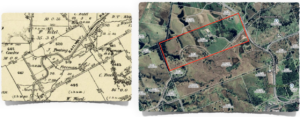
“Farming at Rosewood Scrub”, an article from the Brisbane Courier, 5 August 1876, page 6 gave this information:
Just before arriving at the first German homestead I reached a farm held by Mr. Ponting, who has out of a homestead of eighty acres thirty planted in corn. I went through it all with him, and his own candid opinion was that he had only twenty five bushels per acre, taking it all through. He has sown prairie grass through a portion of the standing corn, and intends planting buffalo grass as soon as he can obtain roots. The sowing down of a portion of the land in grasses is an absolute necessity here, as the natural herbage dies off at certain seasons, and there is nothing left on which stock might be raised. I suggested the corn stalks as fodder, managing them in the same manner as the Americans, but Mr. Ponting told me this had been tried by a neighbor, who cut the corn before it was fully ripe and cooked it in the fields. The result was that the non-matured grain shrivelled up, and the stalks themselves became as dry as if they had been left standing till the corn was ripe, and they did not contain any more nourishment than the latter. The cattle refused the unpalatable fodder. There are thirteen pigs here, two of them of a good looking breed. These are kept for home consumption. The great want of all the farmers appears to be a pig of moderate dimensions for family use, and one of larger growth for sale, both to be quick fatteners and small eaters. If a pig has to be kept for two years before attaining a weight of 200 lbs, he is evidently not a gentleman able to pay the rent, and a rent-payer is what the homesteader wants.
James Ponting was one of the seventeen men who put forward their names to become members of the Rosewood Farmers’ Club (later the A. and H. Association), which was formed at a meeting on Tuesday, 24th July 1877. A committee of nine was elected i.e. James D. Moore (president), John Mitchell, Dan. Desbois, Lawrence Smallbone, John W. Vance, Joseph Hudson, Mark Bensley, William Perrem, and Nicholas Wiegand. The club was established to draw the attention of the authorities and the “powers that be”, to the wonderful fertility of the Rosewood Scrub. These men were the prime movers in deputations and agitations to the Government of the day for the opening of roads and the provision of better facilities for the settlers.
Nine trustees were appointed for the Rosewood cemetery reserve in 1877. James was one of the trustees and he was also one of the 13 foundation members of the Success of Rosewood Lodge No.22, P.A.F.S.O.A in 1883.
James left a tangible and lasting memento of his skill with the mechanics of machinery. He patented a corn husker, sheller and bagger with Shillito and Sons in Ipswich, who in turn, manufactured the machines for the market. The “Queensland Times” of 18th October 1881 reported: The demand of West Moreton farmers for a machine which would both remove the husks of maize and shell the cobs was answered by an invention of a Rosewood farmer, Mr. James Ponting, of Tallegalla. Mr. Ponting claimed that with this machine and the help of a man, he could prepare 20 bags of corn in a day.
In the Queenslander on Saturday 22 October 1881 on page 519, more was reported.
ROSEWOOD. 19th October. The Americans have always got the credit of being first and foremost in discovering and inventing labour-saving machines; but I doubt if any Yankee ever invented a more complete machine for husking and shelling corn than that now at work on Mr. James Ponting’s farm in the Rosewood Scrub. I rode over to Tallegalla last week and had a look at the machine. I will not trouble you with a detailed account of wheels and pulleys and belts, which would fail to convey a correct idea of it, but I may say that it does its work is a thoroughly complete and satisfactory manner. The cobs are, as usual, fed into a hopper at the top of the machine, and the naked cobs and torn husks come out at one side, and the clean corn—ready for market—at the other side. The great difficulty of performing the two operations of husking and shelling at the same time is completely overcome in this machine. Mr. Ponting tells me that with a horse and two or three boys he is able to turn out 120 bushels of maize per day. He has solved the problem that has long puzzled the farmers of Queensland—namely, how to do the husking and shelling in the quickest and cheapest manner.
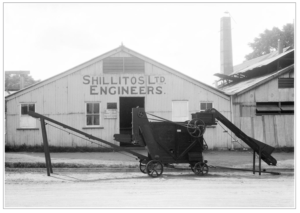
Corn husker in front of Shillitos Ltd, Engineers, West Ipswich, 1927. Src. Picture Ipswich.
There was another write up in the Queensland Times, Ipswich Herald and General Advertiser on Tuesday, 10 November 1885 on page 2.
A trial of “Ponting’s Patent Corn Husker, Sheller, and Bagger” took place at Messrs. S. Shillito and Son’s premises on Saturday afternoon last. Some time ago, we described the machine as we saw it at work on Mr. Ponting’s farm at Rosewood, but improvements have been added since, and material of greater strength and durability used in the construction of the one now under notice. The machine stands about 5ft. in height, and is about the same length, but only 2ft. 6in., or 3ft. in width. A good many wheels and belts are to be seen about it, and horse or steam power is required to work it properly. The price it can be sold at is £16, and its capacity for work is said to be equal to the turning out of five bags of corn per hour. The original one, with horse-power, could turn out four. The unhusked cobs of corn are fed to it just in the same manner as the husked ones are to the ordinary sheller, and they are first manipulated by the machinery of similar make. The iron disc, thickly studded with projecting pieces of metal is there, as is also the smaller bevelled or dish wheel, but the latter is fitted specially to tear the husk, and in this, we believe, the patent chiefly lies. When the machine is driven quickly, as with the steam power on Saturday last, the cobs whiz rapidly through-in fact, it is difficult to feed it quickly enough. The corn husk, the grain, and the inside or core fall on a broad leather endless belt very much perforated by means of a wad-cutter. The grain falls through this, and the husk and core are brought out on the belt, which works round a couple of rollers, and discharged at one end of the machine. A fan blows most of the dust and bran-like matter out at the other end, while the grain falls into a receptacle at one side. From this receiver an elevator- a belt with small tin vessel affixed-conveys the corn to a small box at the top of one end of the machine and affixed to its side. This box is little more than a shoot to which hooks are fixed so that a bag may be hung thereby to receive the grain. A good many farmers inspected the machine, and naturally they looked for, and pointed out what they considered to be defects. For instance they noticed that a few grains were left on some of the corn; but the makers pointed out that this might easily be remedied by putting in a stronger spring. Then again too much grain, it was shown, came out with the refuse, and would have to be sorted over, and put through again for a winnowing. A little grain also was shot out at the “dust” end, and, if the speed was very great, the elevator scattered in proportion. These, however, might not mater much on a good barn floor- but they could, to a great extent, be reminded by a few trifling alterations in the shape and position of various parts of the machine. A person of experience, who was present, pointed out that the bagged corn left nothing to be desired, as it was remarkably clean. Some seemed to think that there was a risk of spoiling the sample through letting bad or rotten cobs through, and, indeed, this is often raised as an objection to machine huskers; but one farmer present said he would reject nine out of every ten bad cobs that passed through his hands as he fed the machine. We might suggest that, when the few alterations shown during the trial to be desirable are made, the machine be tested on some farm for a season’s work. It would, no doubt, show to better advantage when so handled by practical farmers, for we have seen Mr. Pontings old machine do better work than that done on Saturday last, when it was manipulated by himself and family on the farm. The patentee and makers seem to be well satisfied with it, and are sanguine that it will prove a grand success as a labour-saving appliance.
In July-August 1884, James Ponting built the Commercial Hotel on corner of John Street and William Street, Rosewood. He applied for a Country Publican’s Licence which was granted on 19th December. He sold the lease and went back to farming at the end of 1889, later taking it back for a couple of years, before Selina took it on in October 1896 for three years.
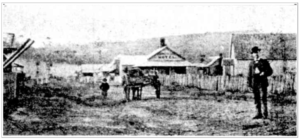
The Commercial Hotel is in the background. c.1885
In 1893, after experimenting with varieties of wheat, he actively promoted the growing of the “Tartar” variety, which he found to be untroubled by rust and it produced a heavy yield. He sent samples to Francis Kates, a miller at Roma, who concluded that it would be a splendid class of cereal and an advantage to farmers in the district if they grew it extensively. Kates’s opinion was respected. He was formerly from Allora, and went on to become the M.L.A. for the Darling Downs. Kates went to Roma in 1883 to build a flour mill, at a cost of at least £3,000, setting a condition that 300 acres of wheat had to be cultivated by selectors.
The land on which a new, larger Farmer’s Club Hall was built in 1900, was purchased from James Ponting. It was next door to his hotel and had a 33ft frontage to John Street. Vinnies Op Shop is now in that building at 25 John Street.
Selina Ponting died in 1904, so thankfully did not have to endure the loss of their son Arthur, who made the supreme sacrifice in the Great War, as did one grandson, Leslie Arthur Boughen. It was said that she was an enthusiastic lover of flowers, and her garden was always a sight worth seeing. As a mark of respect on the day of her funeral, the school flag at Tallegalla was at half-mast throughout the day.
After Selina died, James sold the Commercial Hotel.
James Ponting and Charles Freeman, friends for 63 years, lived side by side for 53 years and died four months apart in 1925. James had been unwell for a few weeks prior to his death but he had been active and alert up until then, frequently visiting Rosewood and Ipswich to carry out his business. Sadly he did not live to see the Rosewood Show Society’s jubilee celebrations in 1927. He was present at the first exhibition, and being the last surviving of the founding members, he had hoped to be present on the day.
James left six sons and four daughters, 27 grandchildren and three great-grandchildren to continue his legacy. Probate was granted to John Waight, Toowoomba (railway employee) and William C. Freeman, Dinmore (miner); realty and personalty £2971.
In September 1927 his property at Tallegalla was sold to Mr. J. Arndt of Tallegalla, through William Ruhno, Auctioneer.
© Jane Schy, 2024
Sources:
Gloucestershire, England, Church of England Baptisms, 1813-1913
New South Wales, Australia, Assisted Immigrant Passenger Lists, 1828-1896
Trove- National Library Australia
